

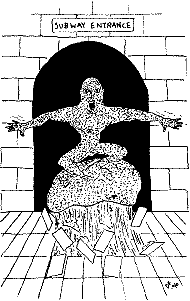
Liege Earth bursts onto the scene. |
Excerpted from The 100 by Michael H. Hart (Citadel Press, 1987)
"I attempted to avoid the question of metahumans when writing this book. Although it is quite possible that some of the people I discussed were possessed of genetic powers, their feats can also be attributed easily to mere legend. Rather, I ignored the question of how metahumans have effected the destiny of humanity simply because it cannot be answered. Metahumans, at least in the quantity and power we know them for today, are strictly a twentieth century phenomenon. The reason for this is unknown, but current theories of power development indicate that the increased exposure to mutagens and carcinogens ranging from high energy particles, to chemicals of all sorts, to mental density from increasing populations, or even the phenomenon of information overload itself may both dispose a person to "mutate" and provide a pool of energy for their powers to draw from. Whereas only three to four metahumans are known to have lived in America at the time of the Revolutionary War, some estimates place the number of American metahumans at almost 40 million. The fact remains, however, that the metahumans' impact on history remains largely unwritten."
Excerpted from Men in the Trenches by Amos Dobson (Doubleday, 1972)
"What of supermen in the Great War? By the time the U.S. entered the war, the new machine guns and other weapons of mass destruction had trimmed the ranks of Europe's metahuman forces, small to begin with, to only a few members: the watery terror Herr U-Boat, London's Noddingham, and only a few insignificant others. The U.S. officially disapproved of the use of metahumans entirely, though tolerance of super-powered vigilantes as a law-enforcement resource in jurisdictions across the country blossomed during American involvement in the war."
Excerpted from Introduction to Criminal Justice by Joseph Senna and Larry Siegal (West Publishing Company, 1990)
"If vigilantes became tolerated during World War I, then they
became accepted and encouraged in the 1920's, at least in areas
like Chicago, where organized crime was prominent. It is even
fair to say that the twenties set the stage for a policy of shadowy
law that would continue until World War II and fostered attitudes
that would remain prevalent until the anti-super tirades of the
HUAC and Joe McCarthy. The spirit of tolerance dwarfed even the
'Free Supers' movement that started in the early 1960's and lasted
until the law and order movements of the 1980's."
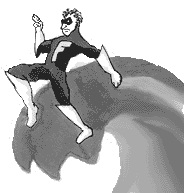
the Force |
Excerpted from Remembering the War by Jeffrey Tyler, Sr. ("Time", 1985)
"In the early part of WWII, supers had little effect on the fighting,
one way or the other. Notable exceptions are the nameless fighters
of the French Resistance, who wreaked havoc on Nazi units with
both stealth and fire power. Further, it can easily be contended
that the success of the Allied attack on Normandy rested on Hitler's
misreading of Allied intentions, leading him to have all the German
uber-mensch stationed elsewhere. In the Pacific theater, the Japanese
Kokoru, the infamous metahuman Samurai, plagued the allied Team
Kismet. There were many other significant metahumans, such as
the U.S. Team Firestrike and the Italian Muscle Squad in Europe,
but they spent almost all their time fighting each other and their
efforts largely cancelled out."
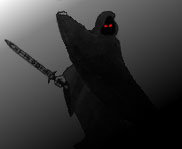
Wraithguard |
Concerned with fostering conciousness and power clusters in animal, the G.A.G. first success was Rex the Wonder Dog in 1950. Although a dog in physical appearance, he manifested extraordinary senses and powerful physical and cognitive abilities. Another early success was Lizard King, who lacked true super powers but showed a knack for management. By 1970, he was the chief executive at the G.A.G. The true accomplishments of the project occurred under his reign: Ramtha, the Dog Squad, Steam Roller, and others. In 1983, the G.A.G. was officially disbanded when a joint effort by the A.C.L.U. and the A.L.F. brought about a court decision granting full autonomy to sentient animals under the project and public opinion forced congress to cut funding [see Fido v. Metadyne (1978)]
During the Vietnam War in the late 1960's, commanders at naval training bases attempted to use high stress and danger training to induce metahuman reactions in the crew. Although ten metahumans were created, only two had powers with a military application and at least thirty-five deaths were linked to the attempt. Although the project was abandoned, it was not revealed to the public until a leak during the Nixon administration.

Sometime around 1975, the Army was looking for a replacement for the Mark IV Ghost Rock suits that had proved ineffective at skirmish tactics in Vietnam, a design largely stemming from research seized from Nazi scientists after WWII. The project was headed by Raleigh Markhem, an ex-gymnast who was crippled by his team mates at a unified training facility when they discovered he was gay. He was largely responsible for the advances in the Mk. I Slaughter suit, which performed exceptionally on all objective scales in covert testing in Central America. By 1984, however, differences between Markhem and the military project analysts came to a head and he was pulled from the project. A month later, a mysterious man in a battle-suit calling himself Hatchetman attacked the Project Slaughter research facility, completely destroying the notes and working prototypes, as well as killing the research team. Markhem went on to serve as head of genetic testing for the Olympics, where, in 1992, his connection to Hatchetman was demonstrated concretely. Army intelligence continues to watch him, hoping to capture the suit and axe, both of which make use of Mk. I technology now unavailable to the army. The current Mk. II Slaughter suits are built on completely different lines and have proved ineffective, most recently in protecting the candidates at a presidential debate in St. Louis.
While their are many explanations for the human power gene, the scientific community is far from reaching a conclusion. In practice, however, all of the theories lead to similar results. Each recognizes that most metahumans get their powers through a life threatening crisis. On all other points, they disagree. Three of the most robust theories are explained below.
Theories developed and popularized by the University of Chicago explained metahuman response as a genetic level evolution to a single situation. In short, the gene code adapts to provide powers that are needed in a crisis. This theory explains why fire elementals are often formed in fires, but fails to explain how such powers as space travel can develop in normal people.
Fixed ability theories contend that an individual has the potential for only one kind of power that can be manifested through a crisis. If a person with the potential for damage resistance or fire powers is caught in a blazing house, he would survive. A person with potential in a very powerful sensory probe, however, would be killed in the fire and never realize his potential.
Combining adaptive and fixed ability theories, cognitive theory states that powers do not develop in a crisis. Rather, the individual merely is forced by his desperation to use them. In the cognitive model, all powers exist in all people, and only one's inhibitions and belief in what is possible control the availability of power. Although not widely held, cognitive theory explains why many people (those with stronger inhibition) do not develop powers during crises, as well as explaining why some supers have seemingly arbitrary and absurd limits on their powers, as with Saturday Night Special's inability to manifest his energy blast without a gun. It also explains the success of the G.A.G., since any sentient creature should have super potential.
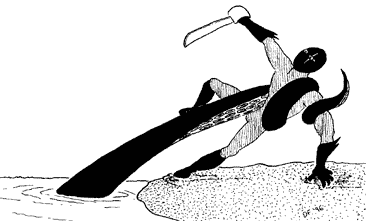
The most recent troubles began in August of 1993, when the group that had been West FIST was turned into a circle of drooling morons by an encounter with the metavillain Major Tom at a circus near New Orleans. Perhaps their troubles began earlier, when they were at ground zero of a nuclear explosion, returning just in time to be killed by an unlikely alliance of battlearmoured villains, and then returning again to catch the perpetrators.
All the same, the powder keg event came at the end of that month.
While giving a speech in Detroit, President Clinton was attacked
by a horde of insectoid metas which were apparently completely
invulnerable to attacks from the Slaughter Suits on bodyguard
duty as well as the members of the Dark Star team that were present.
As usual, the president went "Slick Willy", turning into an enormous
oil elemental. This time, however, he did not just stay put until
the emergency ended. Instead, he attacked and killed the insect
men and then fled into the sewers before any one was able to react.

What exactly triggered the event is unknown, but Wraith Ambassador
Death's Head issued a curious response to requests for aid in
searching for the president: "If I or my men encounter the Klimar,
we will endeavor to kill it. Out of deference to the significance
of the host, and an awareness of Earth's meager defenses, we belay
the usual hunt. For now." His mention of Earth's defenses have
led some, like radio personality Rush Limbaugh, to speculate about
an invasion in the near future.
By the middle of September, the search was generally considered
hopeless, and both houses of congress voted to treat the situation
as if Clinton were, in fact, dead. Al Gore assumed the presidency
and named Hillary Rodham-Clinton as his vice-president.
Former meta villain Ice Pick, after undergoing voluntary psionic therapy to reform her criminality, had been released from prison in late August. As a condition of her parole, she could use none of her super powers. She got a job working at the Gap in a Saint Louis mall. During a hot September day, with the air-conditioning on the fritz, she froze the entire mall, freezing fifteen people to death and causing severe injury to another forty-five others. Despite her insistence that she had made no deliberate use of her powers, she was returned to Dead Lock.
Controlling a political rally in Chicago in early October, Dark Star's Pulse Line advanced her energy fields into the crowd, injuring many and causing a riot. In the final accounting, twelve were killed and over one hundred injured. Although Pulse Line swears that her powers increased without warning, yielding energies on a scale she was not accustomed to controlling, Dark Star was blamed for the entire incident, and their national super team contract was revoked by mid-November.
By December, Bob Dole, sparked by these and half a dozen smaller but similar incidences nationwide, proposed a further strengthening of the Supers Control Acts, which already required superheroes to acquire membership in an approved super team. The new law gave only the federal government the right to license super teams.
By July of 1994, all but two super groups had been officially
ordered to disband, in response to alarming research results.
Researchers first reported the anecdotal result that supers who
wore flashy costumes or used flashy public names were more likely
to have these freak, uncontrollable "power spikes" than those
that did not. Headed by Dr. H. Alan Nur of UCLA, cognitive theorists
argue that such factors decreased a super's grip on reality. The
so-called "power gene", he continues, is not a step of progressive
evolution as often contended. Instead, he compares it to an unstable
genetic disease. Developing powers, he claims, only advances the
disease. Given enough development, any power, even the most benign,
might eventually run amuck and cause incredible catastrophe.
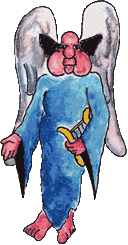
In light of such results, controversial though they were, display of meta-human abilities has become a crime in many jurisdictions. Supers in law enforcement are required to wear standard uniforms and use their "normal" identities. The only two remaining super groups, GAG Order led by management genius Lizard King and The Replacements led by the mysterious Chess Piece, continue only because of ironclad, long term licensure contracts with the government. Although requiring uniforms for superheroes is just like requiring uniforms for any cop and is therefore legal, the constitutionality of a ban on using super powers is yet to have been tested.
Although vigilantism was almost a thing of the past with the enormous numbers of legitimate super groups that sprang up in the 80's, recent months have seen a return of the practice. Meta hero Universal, on the disbanding of her LA based super group, went rogue. She seized control of the terrorist group Supers Underground. Founded in 1972, it was a radical fringe group dedicated to overthrowing the US government and installing an aristocracy of supers. Universal merged it with other underground groups, forging them into a network of vigilantes and unlicensed supers. Although the new Supers Underground is seems to be pro law and order, some heroes ordered to stop using their powers have turned to crime. Still others have left the country. In Europe, for example, metahumans are still immensely in vogue.
None of this is to say that the man on the street in America hates metahumans. 1 in 10 people have powers, after all. Supers are still popular, and many silently cheer for the Underground vigilantes. For all the areas that have criminalized the use of super powers, others have returned to a policy of tacitly supporting vigilante supers. On the whole, though, it has become unwise to advertise one's powers or support for supers. Even for those 1 in 10 with powers, listening to alarmists like Nur, are often hesitant to use their powers, regardless of how trivial they may be.